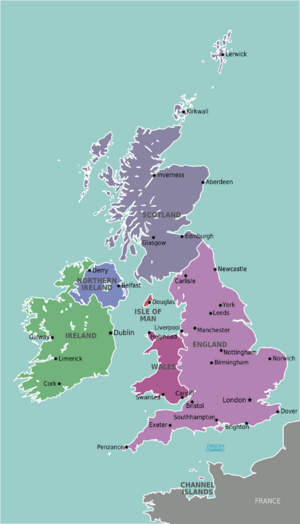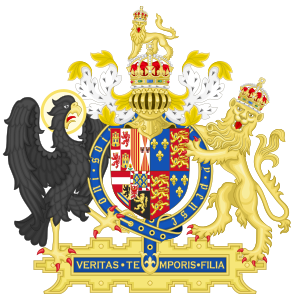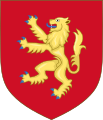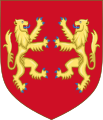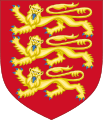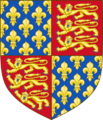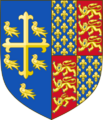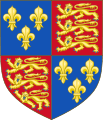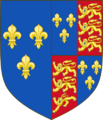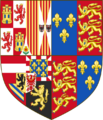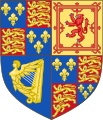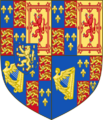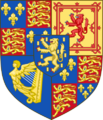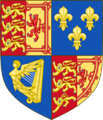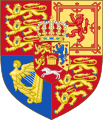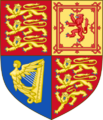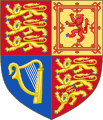List of rulers in the British Isles facts for kids
This article is about the kings and queens who have ruled the different parts of the British Isles. The British Isles are a group of islands in the North Atlantic Ocean, located off the northwest coast of continental Europe. They include large islands like Great Britain and Ireland, as well as smaller ones like the Isle of Man and the Hebrides.
For a long time, England and Scotland were separate kingdoms with their own rulers. In 1603, King James VI of Scotland also became King James I of England. This meant he ruled both countries, but they still had their own separate governments. In 1707, during the reign of Queen Anne, England and Scotland officially joined together to form the new Kingdom of Great Britain. They then shared one parliament in Westminster.
Contents
- England's Early Kings and Queens
- The House of Wessex: Early English Rulers
- The House of Denmark: Viking Kings
- The House of Wessex Returns (First Time)
- The House of Denmark Returns
- The House of Wessex Returns (Second Time)
- The House of Godwin: A Brief Reign
- The House of Wessex Returns (Third Time)
- The House of Normandy: The Norman Conquest
- The House of Blois: A Time of Chaos
- The House of Anjou (Plantagenet): A New Dynasty
- The House of Plantagenet: English Identity Grows
- The House of Lancaster: A New Claim to the Throne
- The House of York: The Wars of the Roses
- The House of Lancaster Returns
- The House of York Returns
- The House of Tudor: A New Era
- The House of Stuart: Uniting the Crowns
- The Interregnum: No King for a Time
- The House of Stuart Returns
- Wales: A Land of Many Rulers
- Scotland: Kings and Queens of the North
- Britain: United Kingdom Monarchs
- Images for kids
- See also
England's Early Kings and Queens
The House of Wessex: Early English Rulers
The House of Wessex was a powerful family that ruled the kingdom of Wessex. Over time, they became kings of all England.
Alfred was king of Wessex starting in 871. He was a very important ruler.
| Ruler | Picture | Born | Family | Died | How they became King |
|---|---|---|---|---|---|
| Alfred the Great 886 – 26 October 899 |
 |
849 Son of Æthelwulf of Wessex |
Ealhswith 5 children |
26 October 899 Aged about 50 |
Son of Æthelwulf of Wessex |
| Edward the Elder 26 October 899 – 17 July 924 |
 |
c. 874 Son of Alfred |
(1) Ecgwynn 2 children (2) Ælfflæd 8 children (3) Eadgifu 4 children |
17 July 924 Aged about 50 |
Son of Alfred |
Who Ruled in 924?
Some historians believe that Ælfweard of Wessex might have been king for a short time in 924, after his father Edward the Elder and before his brother Æthelstan. He was never crowned. Some old records say he ruled for about four weeks, but others say he died only 16 days after his father. It's not clear if he ruled all of England or just Wessex.
| Ruler | Picture | Born | Family | Died | How they became King |
|---|---|---|---|---|---|
| Ælfweard c. 17 July 924 – 2 August 924 |
 |
c. 901 Son of Edward the Elder |
Unmarried? No children | 2 August 924 Aged about 23 |
Son of Edward the Elder |
| Ruler | Picture | Born | Family | Died | How they became King |
|---|---|---|---|---|---|
| Æthelstan 924 – 27 October 939 |
 |
894 Son of Edward the Elder |
Unmarried | 27 October 939 Aged about 45 |
Son of Edward the Elder |
| Edmund I 27 October 939 – 26 May 946 |
 |
c. 921 Son of Edward the Elder |
(1) Ælfgifu of Shaftesbury 2 sons (2) Æthelflæd of Damerham No children |
26 May 946 Killed in a fight, aged about 25 |
Son of Edward the Elder |
| Eadred 26 May 946 – 23 November 955 |
 |
c. 923 Son of Edward the Elder |
Unmarried | 23 November 955 Aged about 32 |
Son of Edward the Elder |
| Eadwig 23 November 955 – 1 October 959 |
 |
c. 940 Son of Edmund I |
Ælfgifu No children |
1 October 959 Aged about 19 |
Son of Edmund I |
| Edgar the Peaceful 1 October 959 – 8 July 975 |
 |
c. 943 Son of Edmund I |
(1) Æthelflæd 1 son (2) Ælfthryth 2 sons |
8 July 975 Aged 31 |
Son of Edmund I |
| Edward the Martyr 8 July 975 – 18 March 978 |
 |
c. 962 Son of Edgar the Peaceful |
Unmarried | 18 March 978 Murdered, aged about 16 |
Son of Edgar the Peaceful |
| Æthelred (1st reign) 18 March 978 – 1013 |
 |
c. 968 Son of Edgar the Peaceful |
(1) Ælfgifu of York 9 children (2) Emma of Normandy 3 children |
23 April 1016 Aged about 48 |
Son of Edgar the Peaceful |
The House of Denmark: Viking Kings
In 1013, England was taken over by Danish kings. Sweyn Forkbeard, a Danish king, invaded England, and Æthelred had to leave the country.
| Ruler | Picture | Born | Family | Died | How they became King |
|---|---|---|---|---|---|
| Sweyn Forkbeard 25 December 1013 – 3 February 1014 |
 |
17 April 963 Son of Harald Bluetooth |
(1) Gunhild of Wenden 7 children (2) Sigrid the Haughty 1 daughter |
3 February 1014 Aged 50 |
Conquered England |
The House of Wessex Returns (First Time)
After Sweyn Forkbeard died, Æthelred the Unready came back from exile and became king again. His son, Edmund, took over after him.
| Ruler | Picture | Born | Family | Died | How they became King |
|---|---|---|---|---|---|
| Æthelred (2nd reign) 3 February 1014 – 23 April 1016 |
 |
c. 968 Son of Edgar the Peaceful |
(1) Ælfgifu of York 9 children (2) Emma of Normandy 3 children |
23 April 1016 Aged about 48 |
Son of Edgar the Peaceful |
| Edmund Ironside 23 April 1016 – 30 November 1016 |
 |
c. 990 Son of Æthelred |
Edith of East Anglia 2 children |
30 November 1016 Aged 26 |
Son of Æthelred |
The House of Denmark Returns
After a big battle in 1016, King Edmund made a deal with Cnut (Canute). Cnut would rule most of England. When Edmund died a month later, Cnut became the sole king of all England for 19 years.
| Ruler | Picture | Born | Family | Died | How they became King |
|---|---|---|---|---|---|
| Canute 18 October 1016 – 12 November 1035 |
 |
c. 995 Son of Sweyn Forkbeard |
(1) Ælfgifu of Northampton 2 sons (2) Emma of Normandy 2 children |
12 November 1035 Aged about 40 |
Son of Sweyn |
| Harold Harefoot 12 November 1035 – 17 March 1040 |
 |
c. 1016 Son of Canute |
Ælfgifu? 1 son? |
17 March 1040 Aged about 24 |
Son of Canute |
| Harthacnut 17 March 1040 – 8 June 1042 |
 |
1018 Son of Canute |
Unmarried | 8 June 1042 Aged about 24 |
Son of Canute |
The House of Wessex Returns (Second Time)
After Harthacnut, the Saxon kings from the House of Wessex ruled again for a short time, from 1042 to 1066.
| Ruler | Picture | Born | Family | Died | How they became King |
|---|---|---|---|---|---|
| Edward the Confessor 8 June 1042 – 5 January 1066 |
 |
c. 1003 Son of Æthelred |
Edith of Wessex No children |
5 January 1066 Aged about 63 |
Son of Æthelred |
The House of Godwin: A Brief Reign
| Ruler | Picture | Born | Family | Died | How they became King |
|---|---|---|---|---|---|
| Harold Godwinson 6 January 1066 – 14 October 1066 |
 |
c. 1022 Son of Godwin |
(1) Edith Swannesha 5 children (2) Ealdgyth 2 sons |
14 October 1066 Killed in battle, aged about 44 |
Chosen by Edward the Confessor and the Witenagemot |
The House of Wessex Returns (Third Time)
After King Harold was killed at the Battle of Hastings, a group of leaders called the Witan chose Edgar Ætheling as king. He ruled for a short time but was never crowned. He later gave up his claim to the throne to William the Conqueror.
| Ruler | Picture | Born | Family | Died | How they became King |
|---|---|---|---|---|---|
| Edgar Ætheling 15 October 1066 – 17 December 1066 |
 |
c. 1051 Grandson of Edmund Ironside |
Unmarried | c. 1126 Aged about 75 |
Grandson of Edmund Ironside Chosen by the Witenagemot |
The House of Normandy: The Norman Conquest
In 1066, several people wanted to be king of England. Harold Godwinson was chosen by the English leaders. But Duke William II of Normandy, a cousin of the previous king, also claimed the throne. William invaded England and won the Battle of Hastings.
William was crowned King William I of England on Christmas Day 1066. He moved the capital from Winchester to London.
| Ruler | Picture | Coat of Arms | Born | Family | Died | How they became King |
|---|---|---|---|---|---|---|
| William I 25 December 1066 – 9 September 1087 |
 |
c. 1028 Son of Robert the Magnificent |
Matilda of Flanders 9 children |
9 September 1087 Aged about 59 |
Conquered England | |
| William II William Rufus 26 September 1087 – 2 August 1100 |
 |
c. 1056 Son of William the Conqueror |
Unmarried | 2 August 1100 Shot with an arrow, aged 44 |
Son of William I | |
| Henry I Henry Beauclerc 5 August 1100 – 1 December 1135 |
 |
September 1068 Son of William the Conqueror |
(1) Matilda of Scotland 2 children (2) Adeliza of Louvain No children |
1 December 1135 Aged 67 |
Son of William I |
The House of Blois: A Time of Chaos
Henry I had no sons who lived to rule. He wanted his daughter, Matilda, to be queen. But when Henry died, his nephew Stephen of Blois quickly took the throne. This led to a long period of fighting known as The Anarchy.
| Ruler | Picture | Coat of Arms | Born | Family | Died | How they became King |
|---|---|---|---|---|---|---|
| Stephen Stephen of Blois 22 December 1135 – 25 October 1154 |
 |
c. 1096 Grandson of William I |
Matilda of Boulogne 6 children |
25 October 1154 Aged about 58 |
Took the throne |
Empress Matilda: A Disputed Queen
Matilda was named as the heir by her father, Henry I. But her cousin, Stephen, took the throne instead. Matilda controlled England for a few months in 1141, but she was never crowned queen. Because of this, she is usually not listed as a monarch of England.
| Ruler | Picture | Coat of Arms | Born | Family | Died | How they became King |
|---|---|---|---|---|---|---|
| Matilda (Title disputed) 7 April 1141 – 1 November 1141 |
 |
7 February 1102 Daughter of Henry I |
(1) Henry V No children (2) Geoffrey Plantagenet 3 sons |
10 September 1167 Aged 65 |
Daughter of Henry I |
The House of Anjou (Plantagenet): A New Dynasty
King Stephen and Matilda eventually made an agreement. Stephen agreed that Henry, Matilda's son, would be the next king. This started a new royal family called the House of Anjou, also known as the House of Plantagenet. These kings ruled a large area from France to Ireland.
| Ruler | Picture | Coat of Arms | Born | Family | Died | How they became King |
|---|---|---|---|---|---|---|
| Henry II Henry Curtmantle 19 December 1154 – 6 July 1189 |
 |
 |
5 March 1133 Grandson of Henry I |
Eleanor of Aquitaine 8 children |
6 July 1189 Aged 56 |
Grandson of Henry I |
| Richard I Richard the Lionheart 3 September 1189 – 6 April 1199 |
 |
 |
8 September 1157 Son of Henry II |
Berengaria of Navarre No children |
6 April 1199 Shot by a crossbow bolt, aged 41 |
Son of Henry II |
| John John Lackland 27 May 1199 – 19 October 1216 |
 |
 |
24 December 1166 Son of Henry II |
(1) Isabel of Gloucester No children (2) Isabella of Angoulême 5 children |
19 October 1216 Aged 49 |
Son of Henry II |
Louis VIII of France: A Disputed King
Louis VIII of France briefly controlled about half of England from 1216 to 1217 during a war against King John. He was welcomed by some English nobles and declared king, but he was never crowned. Later, he agreed that he was not the rightful king of England.
| Ruler | Picture | Coat of Arms | Born | Family | Died | How they became King |
|---|---|---|---|---|---|---|
| Louis (Title disputed) 1216 – 22 September 1217 |
 |
 |
5 September 1187 Son of Philip II of France |
Blanche of Castile 13 children |
8 November 1226 Aged 39 |
Conquered part of England |
The House of Plantagenet: English Identity Grows
The Plantagenet family became more focused on England after they lost most of their lands in France. The Houses of Lancaster and York were later branches of this family.
| Ruler | Picture | Coat of Arms | Born | Family | Died | How they became King |
|---|---|---|---|---|---|---|
| Henry III Henry of Winchester 28 October 1216 – 16 November 1272 |
 |
 |
1 October 1207 Son of John |
Eleanor of Provence 5 children |
16 November 1272 Aged 65 |
Son of John |
| Edward I Edward Longshanks 20 November 1272 – 7 July 1307 |
 |
 |
17 June 1239 Son of Henry III |
(1) Eleanor of Castile 16 children (2) Margaret of France 3 children |
7 July 1307 Aged 68 |
Son of Henry III |
| Edward II Edward of Caernarfon 8 July 1307 – 20 January 1327 |
 |
 |
25 April 1284 Son of Edward I |
Isabella of France 4 children |
21 September 1327 Murdered, aged 43 |
Son of Edward I |
| Edward III 25 January 1327 – 21 June 1377 |
 |
 |
13 November 1312 Son of Edward II |
Philippa of Hainault 14 children |
21 June 1377 Aged 64 |
Son of Edward II |
| Richard II 22 June 1377 – 29 September 1399 |
 |
 |
6 January 1367 Grandson of Edward III |
(1) Anne of Bohemia No children (2) Isabella of Valois No children |
14 February 1400 Aged 33 |
Grandson of Edward III |
The House of Lancaster: A New Claim to the Throne
This family came from Edward III's third son. Henry IV took power from Richard II.
| Ruler | Picture | Coat of Arms | Born | Family | Died | How they became King |
|---|---|---|---|---|---|---|
| Henry IV Henry of Bolingbroke 30 September 1399 – 20 March 1413 |
 |
 |
15 April 1367 Grandson of Edward III |
(1) Mary de Bohun 6 children (2) Joanna of Navarre No children |
20 March 1413 Aged 45 |
Took the throne |
| Henry V 21 March 1413 – 31 August 1422 |
 |
 |
16 September 1386 Son of Henry IV |
Catherine of Valois 1 son |
31 August 1422 Aged 36 |
Son of Henry IV |
| Henry VI (1st reign) 1 September 1422 – 4 March 1461 |
 |
 |
6 December 1421 Son of Henry V |
Margaret of Anjou 1 son |
21 May 1471 Allegedly murdered, aged 49 |
Son of Henry V |
The House of York: The Wars of the Roses
The House of York also claimed the throne. The Wars of the Roses (1455–1485) were a series of fights between the Houses of Lancaster and York for control of England.
| Ruler | Picture | Coat of Arms | Born | Family | Died | How they became King |
|---|---|---|---|---|---|---|
| Edward IV (1st reign) 4 March 1461 – 3 October 1470 |
 |
 |
28 April 1442 Great-great-grandson of Edward III |
Elizabeth Woodville 10 children |
9 April 1483 Aged 40 |
Took the throne |
The House of Lancaster Returns
| Ruler | Picture | Coat of Arms | Born | Family | Died | How they became King |
|---|---|---|---|---|---|---|
| Henry VI (2nd reign) 3 October 1470 – 11 April 1471 |
 |
 |
6 December 1421 Son of Henry V |
Margaret of Anjou 1 son |
21 May 1471 Allegedly murdered, aged 49 |
Took the throne back |
The House of York Returns
| Ruler | Picture | Coat of Arms | Born | Family | Died | How they became King |
|---|---|---|---|---|---|---|
| Edward IV (2nd reign) 11 April 1471 – 9 April 1483 |
 |
 |
28 April 1442 Great-great-grandson of Edward III |
Elizabeth Woodville 10 children |
9 April 1483 Aged 40 |
Took the throne back |
| Edward V 9 April 1483 – 25 June 1483 |
 |
 |
2 November 1470 Son of Edward IV |
Unmarried | Disappeared mid-1483 Allegedly murdered, aged 12 |
Son of Edward IV |
| Richard III 26 June 1483 – 22 August 1485 |
 |
 |
2 October 1452 Great-great-grandson of Edward III |
Anne Neville 1 son |
22 August 1485 Killed in battle, aged 32 |
Took the throne |
The House of Tudor: A New Era
The Tudor family came to power when Henry VII defeated Richard III in 1485, ending the Wars of the Roses. Henry married Elizabeth of York, bringing together the Lancaster and York families.
With Henry VIII, the monarch also became the head of the Church of England.
| Ruler | Picture | Coat of Arms | Born | Family | Died | How they became King |
|---|---|---|---|---|---|---|
| Henry VII 22 August 1485 – 21 April 1509 |
 |
 |
28 January 1457 Great-great-great-grandson of Edward III |
Elizabeth of York 8 children |
21 April 1509 Aged 52 |
Conquered the throne |
| Henry VIII 22 April 1509 – 28 January 1547 |
 |
 |
28 June 1491 Son of Henry VII |
(1) Catherine of Aragon 1 daughter (2) Anne Boleyn 1 daughter (3) Jane Seymour 1 son (3 further marriages) |
28 January 1547 Aged 55 |
Son of Henry VII |
| Edward VI 28 January 1547 – 6 July 1553 |
 |
 |
12 October 1537 Son of Henry VIII |
Unmarried | 6 July 1553 Aged 15 |
Son of Henry VIII |
Lady Jane Grey: A Nine-Day Queen
Edward VI named Lady Jane Grey as his heir in his will, even though Parliament had set a different order of succession. Jane was proclaimed queen for nine days in July 1553. However, Edward VI's half-sister Mary was then proclaimed queen instead. Jane was executed in 1554, at the age of 16.
| Ruler | Picture | Coat of Arms | Born | Family | Died | How they became Queen |
|---|---|---|---|---|---|---|
| Jane (Title disputed) 10 July 1553 – 19 July 1553 |
 |
 |
October 1537 Great-granddaughter of Henry VII |
Guildford Dudley No children |
12 February 1554 Executed, aged 16 |
Named heir by Edward VI |
| Ruler | Picture | Coat of Arms | Born | Family | Died | How they became Queen/King |
|---|---|---|---|---|---|---|
| Mary I Bloody Mary 19 July 1553 – 17 November 1558 |
 |
 |
18 February 1516 Daughter of Henry VIII |
Philip II of Spain No children |
17 November 1558 Aged 42 |
Daughter of Henry VIII |
| Philip (Co-ruler with Mary I) 25 July 1554 – 17 November 1558 |
 |
 |
21 May 1527 Son of Charles V |
Mary I of England No children |
13 September 1598 Aged 71 |
Husband of Mary I |
Under the marriage agreement, Philip shared Mary I's titles and honors. Official documents and laws were made in both their names. Coins were even minted with both their faces.
| Ruler | Picture | Coat of Arms | Born | Family | Died | How they became Queen |
|---|---|---|---|---|---|---|
| Elizabeth I 17 November 1558 – 24 March 1603 |
 |
 |
7 September 1533 Daughter of Henry VIII |
Unmarried | 24 March 1603 Aged 69 |
Daughter of Henry VIII |
The House of Stuart: Uniting the Crowns
When Elizabeth I died without children in 1603, her cousin, King James VI of Scotland, became King James I of England. This event is called the Union of the Crowns. James was related to the Tudors through his great-grandmother, Margaret Tudor. In 1604, he started calling himself "King of Great Britain," but England and Scotland still had separate parliaments until 1707.
| Ruler | Picture | Coat of Arms | Born | Family | Died | How they became King |
|---|---|---|---|---|---|---|
| James I 24 March 1603 – 27 March 1625 |
 |
 |
19 June 1566 Son of Mary, Queen of Scots |
Anne of Denmark 7 children |
27 March 1625 Aged 58 |
Great-great-grandson of Henry VII |
| Charles I 27 March 1625 – 30 January 1649 |
 |
 |
19 November 1600 Son of James I |
Henrietta Maria of France 9 children |
30 January 1649 Executed, aged 48 |
Son of James I |
The Interregnum: No King for a Time
After Charles I was executed in 1649, England had no monarch until Charles II returned in 1660. This period is called the Interregnum.
From 1649 to 1653, England was ruled by Parliament. Then, in 1653, Oliver Cromwell took control and became the Lord Protector. He was like a military leader.
Cromwell chose his son, Richard Cromwell, to take over after him. But Richard wasn't a strong leader and was removed in 1659. After some more chaos, the monarchy was brought back, and Charles II became king.
| Lords Protector | Picture | Coat of Arms | Born | Family | Died |
|---|---|---|---|---|---|
| Oliver Cromwell 16 December 1653 – 3 September 1658 |
 |
 |
25 April 1599 Son of Robert Cromwell |
Elizabeth Bourchier 9 children |
3 September 1658 Aged 59 |
| Richard Cromwell Tumbledown Dick 3 September 1658 – 7 May 1659 |
 |
 |
4 October 1626 Son of Oliver Cromwell |
Dorothy Maijor 9 children |
12 July 1712 Aged 85 |
The House of Stuart Returns
After the monarchy was restored, Charles II ruled. His brother, James II, became king after him, but James was Catholic, which caused problems.
James II was removed from power by Parliament during the Glorious Revolution. His daughter Mary II and her husband William III became the new rulers. A law called the Act of Settlement 1701 made sure that no Catholic could ever be king or queen.
After the Acts of Union 1707, England became part of the new Kingdom of Great Britain.
| Ruler | Picture | Coat of Arms | Born | Family | Died | How they became King/Queen |
|---|---|---|---|---|---|---|
| Charles II 29 May 1660 – 6 February 1685 |
 |
 |
29 May 1630 Son of Charles I |
Catherine of Braganza No children |
6 February 1685 Aged 54 |
Son of Charles I |
| James II 6 February 1685 – 23 December 1688 |
 |
 |
14 October 1633 Son of Charles I |
(1) Anne Hyde 8 children (2) Mary of Modena 7 children |
16 September 1701 Aged 67 |
Son of Charles I |
| Mary II 13 February 1689 – 28 December 1694 |
 |
 |
30 April 1662 Daughter of James II |
William III of England No children |
28 December 1694 Aged 32 |
Offered the Crown by Parliament |
| William III William of Orange 13 February 1689 – 8 March 1702 |
 |
 |
4 November 1650 Grandson of Charles I |
Mary II of England No children |
8 March 1702 Aged 51 |
Offered the Crown by Parliament |
| Anne 8 March 1702 – 1 May 1707 (Queen of Great Britain until 1 August 1714) |
 |
 |
6 February 1665 Daughter of James II |
George of Denmark No surviving children |
1 August 1714 Aged 49 |
Daughter of James II |
Wales: A Land of Many Rulers
Wales never had one single "King of Wales" for a long time, unlike England or Scotland. Many different leaders claimed the title, but the country was only truly united once, under Gruffydd ap Llywelyn from 1055 to 1063.
Scotland: Kings and Queens of the North
The House of Alpin (848–1034)
This family ruled Scotland for many years. The crown often passed between different branches of the family, sometimes with fighting. Malcolm II was the last king of this house. He made sure his grandson, Duncan I, would become king next.
| Portrait | King's Name | Born | Family | Reign | Title | Nickname |
|---|---|---|---|---|---|---|
 |
Kenneth I MacAlpin (Coinneach mac Ailpein) |
Son of Alpin | 843/848 – 13 February 858 | King of the Picts | The Conqueror | |
 |
Donald I (Dòmhnall mac Ailpein) |
Brother of Kenneth I | 858 – 13 April 862 | King of the Picts | ||
 |
Constantine I (Còiseam mac Choinnich) |
Son of Kenneth I | 862–877 | King of the Picts | The Wine-Bountiful | |
 |
Áed (Aodh mac Choinnich) |
Son of Kenneth I | 877–878 | King of the Picts | ||
 |
Giric (Griogair mac Dhunghail) |
Son of Donald I? | 878–889 | King of the Picts | Son of Fortune | |
 |
Eochaid | Grandson of Kenneth I* | 878–889?* | King of the Picts | ||
 |
Donald II (Dòmhnall mac Chòiseim) |
Son of Constantine I | 889–900 | King of Scotland | The Madman | |
 |
Constantine II (Còiseam mac Aoidh) |
Son of Áed | 900–943 | King of Scotland | The Middle Aged | |
 |
Malcolm I (Maol Chaluim mac Dhòmhnaill) |
Son of Donald II | 943–954 | King of Scotland | The Dangerous Red | |
 |
Indulf | Son of Constantine II | 954–962 | King of Scotland | The Aggressor | |
 |
Dub (Dubh or Duff) |
Son of Malcolm I | 962–967 | King of Scotland | The Vehement | |
 |
Cuilén (Cailean) |
Son of Indulf | 967–971 | King of Scotland | The White | |
| Amlaíb (Amhlaigh) |
Son of Indulf | 973–977‡ | King of Scotland | |||
 |
Kenneth II (Coinneach mac Mhaoil Chaluim) |
Son of Malcolm I | 971–995 | King of Scotland | The Fratricide | |
 |
Constantine III (Còiseam mac Chailein) |
Son of Cuilén | 995–997 | King of Scotland | ||
 |
Kenneth III (Coinneach mac Dhuibh) |
Son of Dub | 997 – 25 March 1005 | King of Scotland | The Chief/The Brown | |
 |
Malcolm II (Maol Chaluim mac Choinnich) |
Son of Kenneth II | 1005–1034 | King of Scotland | The Destroyer |
*Eochaid's reign is not clear. He might have been a co-king with Giric. ‡Amlaíb's reign is only known from a record of his death.
The House of Dunkeld (1034–1286)
Duncan became king as the grandson of Malcolm II. He was killed by Macbeth. Later, Duncan's son Malcolm III defeated Macbeth and became king. This family ruled Scotland for a long time, usually passing the throne from father to son.
| King's Name (Reign) |
Portrait | Title | Nickname | Marriages | Family Status |
|---|---|---|---|---|---|
| Duncan I (1034–1040) |
 |
King of Scotland | The Diseased | Suthen at least two sons |
Grandson of Malcolm II |
| Macbeth (1040–1057) |
 |
King of Scotland | The Red King | Gruoch of Scotland no children |
Son of Mormaer Findláech |
| Lulach (1057–1058) |
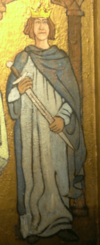 |
King of Scotland | The Unfortunate The Foolish |
Unknown two children |
Step-son of Macbeth |
| Malcolm III (1058–1093) |
 |
King of Scotland | Canmore "Great Chief" |
Ingibiorg Finnsdottir three sons Margaret of Wessex eight children |
Son of Duncan I |
| Donald III (1093–1097) |
King of Scotland | The Fair | Unknown at least one daughter |
Son of Duncan I | |
| Duncan II (1094) |
 |
King of Scotland | Uchtreda of Northumbria one son |
Son of Malcolm III | |
| Edgar (1097–1107) |
 |
King of Scotland | The Valiant | None | Son of Malcolm III |
| Alexander I (1107–1124) |
 |
King of Scotland | The Fierce | Sybilla of Normandy no children |
Son of Malcolm III |
| David I (1124–1153) |
 |
King of Scotland | The Saint | Maud, Countess of Huntingdon four children |
Son of Malcolm III |
| Malcolm IV (1153–1165) |
 |
King of Scotland | The Maiden Great Chief |
None | Grandson of David I |
| William I (1165–1214) |
 |
King of Scotland | The Lion The Rough |
Ermengarde de Beaumont four children |
Grandson of David I |
| Alexander II (1214–1249) |
 |
King of Scotland | Joan of England no children Marie de Coucy one son |
Son of William I | |
| Alexander III (1249–1286) |
 |
King of Scotland | Margaret of England three children Yolande de Dreux no children |
Son of Alexander II |
The House of Sverre (1286–1290)
The status of Margaret, Maid of Norway, as a Scottish queen is debated. She was never officially crowned.
| Name | Portrait | Born | Marriage(s) | Died | Family Status |
|---|---|---|---|---|---|
| Margaret the Maid of Norway 1286–1290 |
 |
c. April 1283 Daughter of Eric II of Norway |
None | September/October 1290 Aged 7 |
Granddaughter of Alexander III |
First Interregnum (1290–1292)
After Margaret's death, Scotland had no king for two years because there was no clear heir.
The House of Balliol (1292–1296)
Many people claimed the Scottish throne. Edward I of England was asked to decide. He chose John Balliol, but he made the Scots promise loyalty to him. John Balliol was not a strong king and was forced to give up his throne in 1296. Edward I then tried to take over Scotland.
| Name | Portrait | Born | Marriage(s) | Died | Family Status |
|---|---|---|---|---|---|
| John Balliol Toom Tabard ("Empty Cloak") 1292–1296 |
 |
c. 1249 | Isabella de Warenne at least one son |
c. 25 November 1314 | Great-grandson of David of Huntingdon (brother of William I) |
Second Interregnum (1296–1306)
Scotland had no king for ten years after John Balliol.
The House of Bruce (1306–1371)
The Scots fought against English rule. Robert the Bruce became a leader and was crowned King of Scots in 1306. He defeated the English at the Battle of Bannockburn in 1314, and Scotland became independent. Robert's son, David, became king as a child. David had to flee when Edward Balliol tried to take the throne. David later returned, but he had no children, and the House of Bruce ended.
| Name | Portrait | Born | Marriage(s) | Died | Family Status |
|---|---|---|---|---|---|
| Robert I the Bruce 1306–1329 |
 |
11 July 1274 | (1) Isabella of Mar one daughter (2) Elizabeth de Burgh four children |
7 June 1329 | Great-great-grandson of David of Huntingdon |
| David II 1329–1371 |
 |
5 March 1324 | (1) Joan of England no children (2) Margaret Drummond no children |
22 February 1371 | Son of Robert I |
Edward Balliol: A Disputed King
Edward Balliol was the son of King John Balliol. He tried to take the Scottish throne during David II's childhood, with English support. He was crowned king in 1332 but was quickly driven out. He made several attempts to regain the throne but never held it for long. He gave up his claim in 1356.
| Name | Portrait | Born | Marriage(s) | Died | Claim |
|---|---|---|---|---|---|
| Edward Balliol 1332–1356 (In opposition to David II) |
 |
1283 Son of John Balliol |
None | 1367 | Son of John Balliol |
The House of Stewart/Stuart (1371–1651)
This family began with Robert the Stewart, grandson of Robert I. Many of these kings were young when they took the throne, leading to periods where nobles had more power.
James VI became King of England and Ireland in 1603. His son, Charles I, faced a Civil War and was executed. The English Parliament then ended the monarchy. However, the Scottish Parliament declared Charles II, Charles I's son, as their king. He ruled until 1651 when Oliver Cromwell's armies took over Scotland.
| Name | Portrait | Born | Marriage(s) | Died | Family Status |
|---|---|---|---|---|---|
| Robert II the Stewart 1371–1390 |
 |
2 March 1316 | (1) Elizabeth Mure ten children (2) Euphemia de Ross four children |
19 April 1390 | Grandson of Robert I |
| Robert III the Lame King 1390–1406 |
 |
c. 1337 | Anabella Drummond seven children |
4 April 1406 | Son of Robert II |
| James I 1406–1437 |
 |
July 1394 | Joan Beaufort eight children |
21 February 1437 | Son of Robert III |
| James II Fiery Face 1437–1460 |
 |
16 October 1430 | Mary of Guelders seven children |
3 August 1460 | Son of James I |
| James III 1460–1488 |
 |
10 July 1451 | Margaret of Denmark three children |
11 June 1488 | Son of James II |
| James IV 1488–1513 |
 |
17 March 1473 | Margaret Tudor six children |
9 September 1513 Killed in battle |
Son of James III |
| James V 1513–1542 |
 |
15 April 1512 | (1) Madeleine of Valois no children (2) Mary of Guise three children |
14 December 1542 | Son of James IV |
| Mary I 1542–1567 |
 |
8 December 1542 | (1) François II no children (2) Henry Stuart, Lord Darnley one child (3) James Hepburn no children |
8 February 1587 Executed |
Daughter of James V |
| James VI 1567–1625 |
 |
19 June 1566 | Anne of Denmark seven children |
27 March 1625 | Son of Mary I |
| Charles I 1625–1649 |
 |
19 November 1600 | Henrietta Maria of France nine children |
30 January 1649 Executed |
Son of James VI |
| Charles II 1649–1651 |
 |
29 May 1630 | Catherine of Braganza no children |
6 February 1685 | Son of Charles I |
Third Interregnum (1651–1660)
Scotland also had a period without a king when it was under the control of the Commonwealth of England.
The House of Stuart Restored (1660–1707)
The Stuart kings returned to Scotland. Charles II ruled, and then his brother, James VII (also James II of England), became king. James's Catholic faith led to him being removed from power. His Protestant daughter Mary and her husband William of Orange became the new rulers.
Scotland and England officially joined together in 1707 to form the Kingdom of Great Britain. This happened partly because Queen Anne had no surviving children, and there was a concern about who would rule next.
| Name | Portrait | Born | Marriage(s) | Died | Family Status |
|---|---|---|---|---|---|
| Charles II 1660–1685 |
 |
29 May 1630 | Catherine of Braganza no children |
6 February 1685 | Son of Charles I |
| James VII 1685–1688 |
 |
14 October 1633 | (1) Anne Hyde eight children (2) Mary of Modena seven children |
16 September 1701 | Son of Charles I |
| Mary II 1689–1694 |
 |
30 April 1662 | William III of England three children (none survived infancy) |
28 December 1694 | Granddaughter of Charles I |
| William II William of Orange 1689–1702 |
 |
4 November 1650 | Mary II of England three children (none survived infancy) |
8 March 1702 | Grandson of Charles I |
| Anne 1702–1707 (Queen of Great Britain 1707–1714) |
 |
6 February 1665 | George of Denmark 17 children |
1 August 1714 | Daughter of James VII |
Britain: United Kingdom Monarchs
The House of Stuart (1707–1714)
Anne became Queen of Great Britain when England and Scotland united in 1707.
| Ruler | Picture | Coat of Arms | Born | Family | Died | How they became Queen |
|---|---|---|---|---|---|---|
| Anne 1 May 1707 – 1 August 1714 |
 |
 |
6 February 1665 Daughter of James II and VII |
Prince George of Denmark No surviving children |
1 August 1714 Aged 49 |
Daughter of James II and VII |
The House of Hanover (1714–1901)
After Anne died without children, the throne went to her second cousin, George Louis. This was because of the Act of Settlement 1701, which said that only Protestants could inherit the throne. George was the son of Sophia of Hanover, who was a granddaughter of James VI and I.
| Ruler | Picture | Coat of Arms | Born | Family | Died | How they became King/Queen |
|---|---|---|---|---|---|---|
| George I George Louis 1 August 1714 – 11 June 1727 |
 |
 |
28 May 1660 Great-grandson of James VI and I |
Sophia Dorothea 2 children |
11 June 1727 Aged 67 |
Chosen by Act of Settlement |
| George II George Augustus 11 June 1727 – 25 October 1760 |
 |
 |
30 October 1683 Son of George I |
Caroline 8 children |
25 October 1760 Aged 76 |
Son of George I |
| George III George William Frederick 25 October 1760 – 29 January 1820 |
 |
 |
4 June 1738 Grandson of George II |
Charlotte of Mecklenburg-Strelitz 15 children |
29 January 1820 Aged 81 |
Grandson of George II |
| George IV George Augustus Frederick 29 January 1820 – 26 June 1830 |
 |
 |
12 August 1762 Son of George III |
(1) Maria Fitzherbert No children (2) Caroline 1 daughter |
26 June 1830 Aged 67 |
Son of George III |
| William IV William Henry 26 June 1830 – 20 June 1837 |
 |
 |
21 August 1765 Son of George III |
Adelaide of Saxe-Meiningen 2 daughters |
20 June 1837 Aged 71 |
Son of George III |
| Victoria Alexandrina Victoria 20 June 1837 – 22 January 1901 |
 |
 |
24 May 1819 Granddaughter of George III |
Albert 9 children |
22 January 1901 Aged 81 |
Granddaughter of George III |
The Houses of Saxe-Coburg and Gotha and Windsor
When Edward VII became king in 1901, he started a new royal family name, Saxe-Coburg and Gotha, because of his father. Later, in 1917, during World War I, King George V changed the family name to Windsor because of strong anti-German feelings in the country.
| Ruler | Picture | Coat of Arms | Born | Family | Died | How they became King/Queen |
|---|---|---|---|---|---|---|
| Edward VII Albert Edward 22 January 1901 – 6 May 1910 |
 |
 |
9 November 1841 Son of Victoria |
Alexandra of Denmark 6 children |
6 May 1910 Aged 68 |
Son of Victoria |
| George V George Frederick Ernest Albert 6 May 1910 – 20 January 1936 |
 |
 |
3 June 1865 Son of Edward VII |
Mary of Teck 6 children |
20 January 1936 Aged 70 |
Son of Edward VII |
| Edward VIII Edward Albert Christian George Andrew Patrick David 20 January 1936 – 11 December 1936 |
 |
 |
23 June 1894 Son of George V |
Wallis Simpson No children |
28 May 1972 Aged 77 |
Son of George V |
| George VI Albert Frederick Arthur George 11 December 1936 – 6 February 1952 |
 |
 |
14 December 1895 Son of George V |
Elizabeth Bowes-Lyon 2 daughters |
6 February 1952 Aged 56 |
Son of George V |
| Elizabeth II Elizabeth Alexandra Mary 6 February 1952 – 8 September 2022 |
 |
 |
21 April 1926 Daughter of George VI |
Prince Philip 4 children |
8 September 2022 Aged 96 |
Daughter of George VI |
| Charles III Charles Philip Arthur George 8 September 2022 – present |
 |
 |
14 November 1948 Son of Elizabeth II |
(1) Diana Spencer 2 sons (2) Camilla Parker Bowles No children |
Living | Son of Elizabeth II |
Images for kids
See also


